What Nature Has To Say About Gender
6Feb 13, 2018 by Rua Lupa
This was originally published on Feb 10, 2015 on Patheos.
It is now being republished with some editing for clarification. Updated: Feliformia 25th / 12018 HE — February 13th / 2018 CE.
Updated: Pecora 21st / 12020 HE — January 10th / 2020 CE.
Life is fascinating. It comes in all shapes, sizes and expression. Most of life on earth reproduces asexually – meaning that they copy themselves as clones. The majority of animals on earth reproduce sexually – as you may have guessed means that they combine genetic material from two different organisms creating new unique organisms. The form this usually takes is in sexual divergences wherein one provides sperm and the other provides the egg. The first animals to do this have completed this reproduction via external egg that becomes incubated and then hatches, typically done by the one that provided the egg, but not always. Mammals had developed a different approach by incubating that egg internally in one of the parents until it is birthed out of the parent, again most typically by the one providing the egg, but not always.

Cassowary Father Hatches & Raises Chicks. Image Source: abc.net.au

Large Mouth Bass Father Guarding Eggs, Photo Credit: Chester Allen
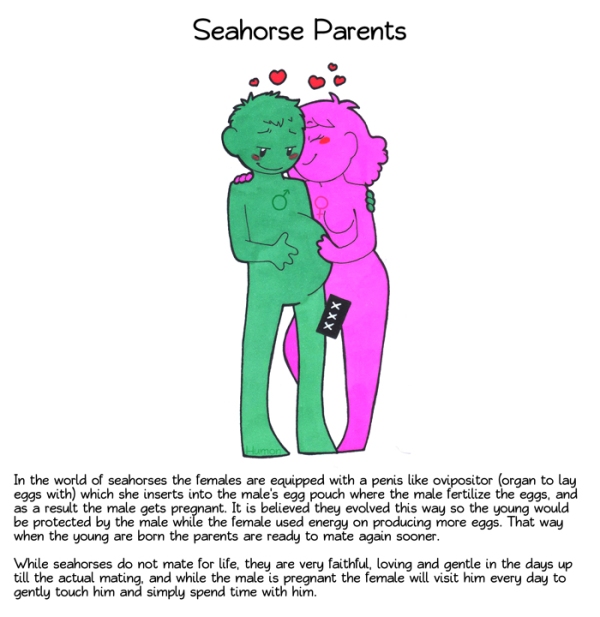
Seahorse Reproduction. Image Credit: Humon Comics. Source: http://humoncomics.com/archive/animal-lives
Dimorphism
We have named those that provide the sperm male, and those that provide the egg female, having no other meaning biologically speaking. In most species of animal this sexual dimorphism is emphasized in secondary sex characteristics wherein the outer physical appearance differs between males and females, mostly becoming expressed at sexual maturity. This can appear as a difference in body size, physical strength and morphology, ornamentation, behaviour and other bodily traits.
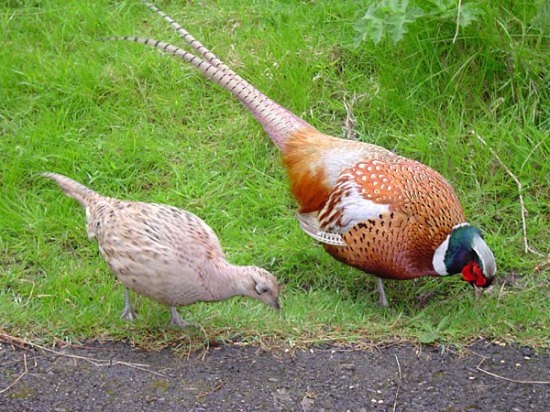
Female (left) and male (right) common pheasant, illustrating the dramatic difference in both color and size between sexes. Photo Credit: ChrisO
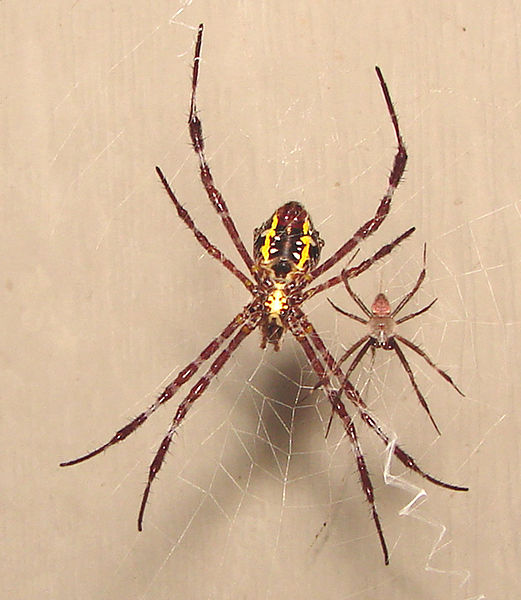
Female (left) and Male (right) Argiope appensa, displaying typical sexual dimorphism differences in spiders where the male is dramatically smaller. Photo Credit: Sanba38
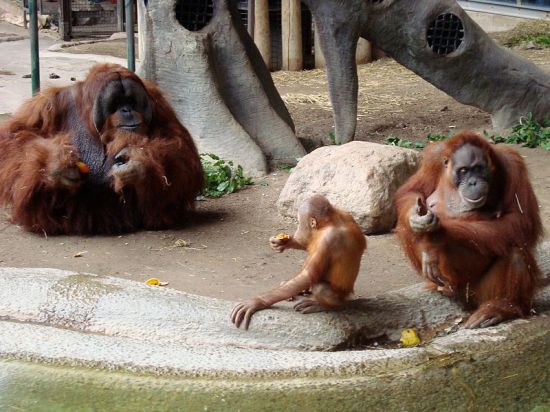
Male (left), offspring, and female (right) Sumatran orangutans. Photo Credit: Jeffery J. Nichols
The amount of difference of gender dimorphism between male and female humans is as much different as male and female wolves, chimpanzees, and lemurs. That being that the secondary traits are relatively minor. Otherwise the main differences remain as a reflection of individual personality.

Chimpanzees. The male common chimp stands up to 1.7 m (5.6 ft) high and weighs as much as 70 kg (150 lb); the female is somewhat smaller. Photo Credit: Zoo Docents at Jackson Zoo
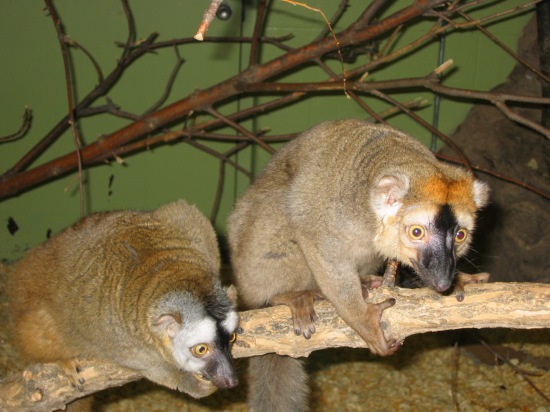
Red Lemur Pair. Males have white or cream colored cheeks and beards, while females have rufous or cream cheeks and beards that are less bushy than males. Photo Credit: ChrisStubbs
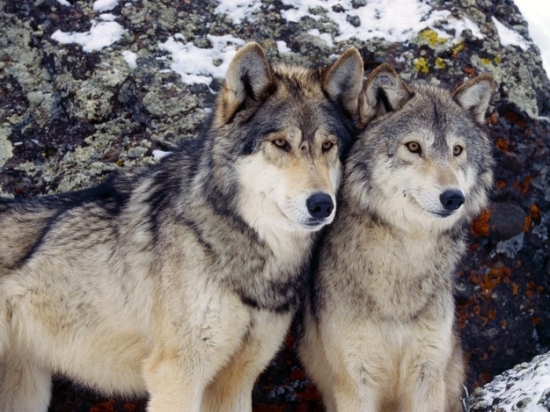
Alpha Wolf Pair. Males have broader skulls, more robust limb bones, and higher muscle mechanical advantages than females. Photo Source: wallpapersimg.com
Gender Middle
In sexual reproduction there are entire species and some individuals in many other species that have both egg and sperm producing organs called hermaphrodites.
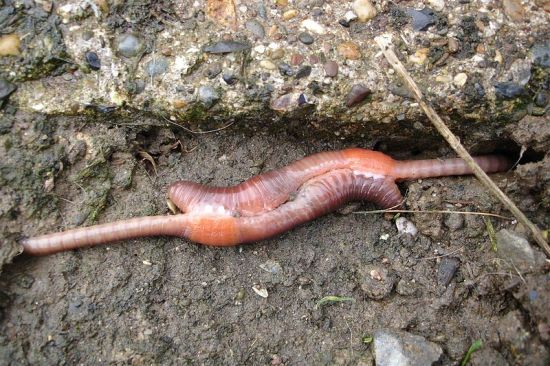
Hermaphrodites: Earthworms Mating. Photo Credit: Jackhynes, image released into public domain
In species that are not typically hermaphroditic it is termed intersex and usually one or both organs are inert, sometimes one reproductive organ being more visually apparent leaving the other going unnoticed until an autopsy is done. When sexual maturity is reached for these individuals one reproductive aspect usually develops in a more pronounced way than the other, or does not become activated at all, and can not be reliably predicted which it would be when the time comes.
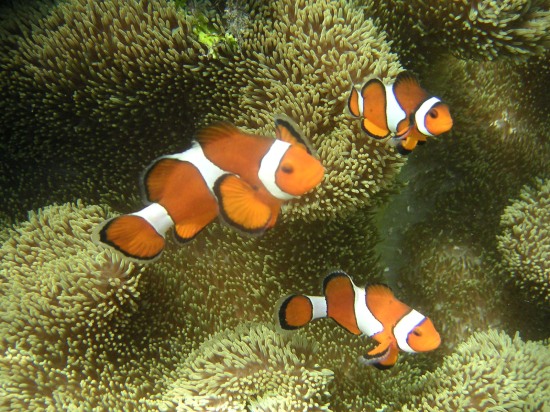
Hermaphrodites: Clownfish are initially male; the largest fish in a group becomes a female and can change back to male again when a larger fish is in the group. Photo Credit: Metatron
Intersex humans are as common as redheads – that is 1 in 200 people (this number can vary depending on methodology and interpretation). Which means that more likely than not, you have met a number of intersex people already.
This state of being is commonly described as Androgynous or Transgender. Whereas people who identify with the gender they were assigned based on anatomical features observed at birth are described as Cis-Gendered – Cis Man or Cis Woman.
Human cultures have denied the existence of intersex individuals to the point that infants that express intersex characteristics are killed or mutilated – surgically altering them to look like the gender that looks more prominent at birth in order to conform to societal expectations. These children are raised believing they are one gender and upon sexual maturity often find themselves in strange circumstances where they develop differently from their peers.
Others, that do not have any external intersex characteristics, tend to find out when a medical issue arises and is found by doctors. This includes the biggest sexual organ and the seat of identity – the brain, and commonly arises in the form of Gender dysphoria.
Some have found that getting sex reassignment surgery and/or hormone treatment to become aligned with the gender they most associate with helps them feel more like their true self; Removing the anxiety of facing social retaliation for not fitting into societal expectations and enabling them to move forward in a more self empowering way.
Understandably, those that find themselves to be intersex become very distressed as there is no way of expressing this state of being without the social pressure to conform to the male/female dimorphic stereotypes in society. In addition to that is the personal question of sexual orientation and how to go about finding a significant other in life in a society that is still hetero-normative (assumes only two genders and opposite gender attraction – which nature has disproven extensively. see link to Humon Comics via clicking image or link at bottom of article)

Gender Expression?
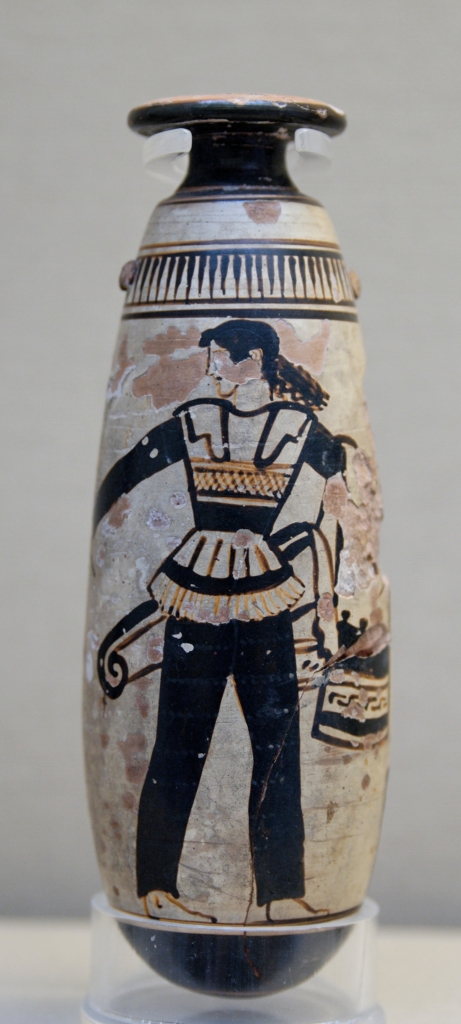
Amazon wearing trousers and carrying a shield with an attached patterned cloth and a quiver. Ancient Greek Attic white-ground alabastron, ca. 470 BC, British Museum, London. Photo Credit: Marie-Lan Nguyen (2007)
Humans, as a species, have had virtually every form of expression for all genders already in history, but gendered stereotyped clothing usually comes about in unforeseen ways.
Trousers (Pants in North America and Australia) were worn by the Celts for functionality by both men and women for warmth, outdoor work and to ride horses. Koreans might have worn trousers around the same time for the same purposes too. Meanwhile most cultures in surrounding regions wore wraps or tunics or the combination of the two and thought that wearing pants was uncivilized. It was around the time of Christianization that women wearing trousers became taboo. But now we see women everywhere adorning trousers / pants.
High heel shoes, for example, were invented by Persian horse archers for functionality, because they helped hold the rider’s foot in stirrups. European gentry had then taken a liking to them at court as a form of fashion. In the early 1600’s women had adopted the high heel footwear as well, which caused it to fall out of fashion as “men’s wear”.
I think you may start seeing the trend here – clothing begins purely for function and is not gender restrained, only becoming so after stereotypes become established.
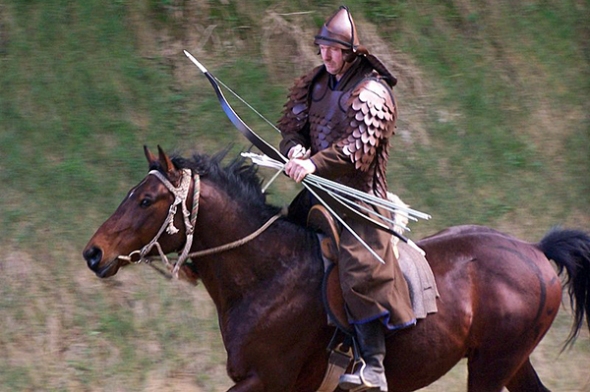
Kassai Canada School of Mounted Archery. Image Source: .e-know.ca/sports/horseback-archery-competition-in-the-valley/
Forms of dress and behaviour naturally arise in reflection of personality and activities. If you enjoy performance arts then you would be likely inclined toward flowing vibrant forms of clothing and manner. If you enjoy competitive team athletics then you would likely be inclined toward form fitting, free movement, protective clothing, and forward behaviour. If you enjoy woodworking, then your clothing would incline toward comfortable and protective, with a more focused and calm behaviour. And even then many would have multiple interests that may include many of these expressions and/or others, and not even necessarily being anything like I mentioned earlier. Which could be way off depending on personality and how an individual or group approaches any subject. We are inventive creatures after all, which is the primary trait of our species that should be celebrated instead of regulated to suit expectations.
As a naturalist other species are not separated with categories of sex and gender like with what we are currently seeing being attempted in human society because it simply does not exist in other species. This then, comes across as another method to culturally perceive humans as separate from animals, and somehow separate from the rest of nature, when all the while we are animals. I understand that the reasoning behind this attempted separation is to label gender roles in cultures. But that perpetuates a problem,
We have been consistently finding that enforced gender roles (gender expressions) are detrimental, to both the health of people and society. Be that hyper-masculinity / toxic masculinity, denying women bodily autonomy, and denying intersex people a place in society.
The reality is that there are no limits to what someone can wear and do. “Feminine” and “Masculine” are just arbitrary classifications that are believed and enforced by society, and every explanation I have seen to justify “feminine” and “masculine” consistently refers to attraction to secondary sex characteristics anyway. Which is fine and why we see heterosexual attraction between Cis Women and Trans Men / Cis Men and Trans Women. That innate attraction is legitimate and does not require the arbitrary cultural baggage of “feminine” and “masculine” that in most every case are lies about what it means to be a man or woman. More often than not with ties to marketing schemes that play on our insecurities on wanting to fit in so you purchase their product (“do not lose your “man card”!”, “Real Men”, “Lady’s Man”, “Good Housewife”, “Keep up with the Latest Fashion Trends Ladies”, Pink Products, How to be a “Desirable Woman” etc.).
In conclusion, a separate Gender category for social expression is itself detrimental and are better off without it because ultimately there is no point in separating your sex and gender – your gender as cis woman, trans woman, cis man, trans man, or transgender / androgynous, means you get to define what that means, your gender does not define what you do. Lets all stop boxing ourselves into unnecessary categories that serve no purpose other than perpetuating heteronormativity and dismisses the legitimate existence of Trans Men, Transgender / Androgynous People, and Trans Women. Instead of fighting to have a seat at the binary bench, we should dismantle it and create an inclusive round table for all Genders.

That is something our society needs to understand, so long as we respect human rights and our shared environment, go out and dress and act however you like. The more people freely express themselves, the more society will come to accept humanity for what it is. Not all that different from one another, all the while being beautifully diverse.
If you want to know about what Nature has to say about sexual orientation beyond what was touched on here, Humon Comics: Anmial Lives is a great series that shows the many different ways relationships can happen.
Category: Political Barking, Rua's Rambles, Seasons & Stardust | Tags: Androgynus, Female, Feminine, Gender, Intersex, LGBTQIA, Male, Masculine, Religious Naturalism, sex, Transgender

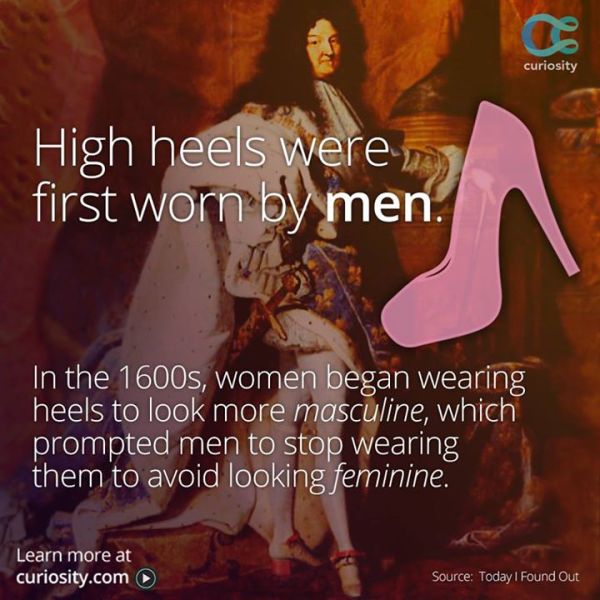
I agree with most of this post! Gender (and sex) are definitely far, far less rigid than mainstream society would like us to believe, and the animal kingdom is full of delightful riffs on sex and reproductive biology that would likely have Christian conservatives screaming in horror. The only point I take issue with in this post is its handling of transgender identity.
It seems to conflate being intersex with being transgender, and implies that being intersex is the only real reason someone would be transgender. In the last paragraphs it seems to reinforce this implication by saying that gender = sex and, since masculinity and femininity are made up, people should not feel a need to transition to a different gender role; and instead should feel secure in simply breaking and expanding the boundaries of their assigned gender.
That is a worthwhile goal but, I think, misses the point. Yes, gender is socially constructed but that doesn’t mean it doesn’t have real consequences in life. There are people who feel dysphoric about their social role, completely unrelated to hormones or being intersex. And the very admission of intersex individuals who identify as male or female is an admission that gender and sex are not the same; otherwise, all intersex individuals would identify as between genders. Sex is the physical characteristics; gender is the social role, and socially constructed does not mean fake. Hell, just about everything is a social construct.
The assertion that sex = gender also ignores the existence of nonbinary individuals, or people who identify as neither male or female, or as both male and female. Being intersex is not a prerequisite for being nonbinary, either, and nonbinary individuals have existed in society for countless millenia, from the two-spirits of Native American culture to the muxe of southern Mexico.
I do not mean to provoke ire or to try and point an accusatory finger; I assume positive intentions in every situation until proving otherwise, and in most respects this post really was a lovely treatise on the non-rigidity of sex and gender roles in both animals and humans. However, as a nonbinary trans individual myself, some of the lines of thought in this post were worrying to me. Because I generally respect and enjoy reading your viewpoint, I felt I couldn’t stay silent.
LikeLiked by 1 person
My reasoning with connecting intersex with transgender is that Transgender is being used to describe a Third Gender that is neither Male, nor Female; it also describes people who are born in male or female externally expressed bodies and experience Gender Dysphoria; including how there are people who are intersex who themselves experience gender dysphoria; and then also includes those who wish to make a transition to more fully male or female; and there are studies that are finding supporting evidence that gender dysphoria is a form of intersex via the brain, called The Brain Sex Theory. That is where I have drawn my conclusion.
What I did not do was go into all the details of what Transgender can mean, hence why I stated, “This state of being and transition, if chosen, is *commonly described* as Transgender.” Because the term is not yet a solid definition and admittedly a sensitive topic that is difficult in having a single accepted definition by everyone who identifies as Transgender. There remains many things that are not agreed upon among the Transgender community, so I did my best to touch on most everything that can be scientifically determined. Gender Dysphoria, though, is specifically defined as a disconnect with your physical biological sex, not your Social Gender Role.
When it comes to people who are intersex/transgender and want to fit in, of course traditional gender roles are going to push people into requiring to align with the traditional ideas of what being that gender means. And that is what makes it have real consequences in life. Intersex/transgender individuals have to find a way to safely navigate society’s expectations all the while trying to find their identity. So naturally it makes sense to align your social behaviour and dress with the gender you most identify with just to be able to be yourself in some way, because currently there is no mainstream social acceptance of a third gender without pressure to express yourself purely as one of the binary options.
Now for your example of not identifying with Gender Roles of a society you are raised in, that is my point about Dropping said Gender Roles. Because it is in fact arbitrary, which no wonder people feel ‘dysphoric’ about it. That is why we have movements like Feminism and LGBTQI+. To change these unrealistic rigid expectations of what it means to be of that gender. So no, being intersex is not a prerequisite for not conforming to these Gender Roles society has placed on us. This outward expression of non-conforming can and do include all genders.
I am glad to hear from a long time reader, I often wonder if anyone is out there as it usually is silent. It pleases me that you have spoken honestly and well about your feelings on this issue and expressed a perspective that I did not express in the article. Your posted comment is a needed perspective on this large topic, even, and perhaps especially, because there is a discrepancy. I would like more comments like yours around on this blog to show how diverse these topics really are and how it is okay to disagree. We all have different ideas about society on how things are and should be and are bound to have a difference in view on something. If you have more to add, or questions on what I have written here, please feel free to do so 🙂
LikeLike
Hi Rua Lupa, another frequent reader here. I too have taken issue with the way you have phrased some things, and based on your response, it would seem that you have some ideas about being trans that are not in line with what most of the community believes. To start, you say in the first paragraph of your response that trans people identify as a third gender. Of the many trans people I have known, only nonbinary individuals feel that they are a separate gender. Transmen are men. Transwomen are women. They are not “in-between” anything, and many within the community feel it is transphobic to approach things in such an exclusionary way, which in general makes it easy to discount the possibility of dating a trans person (ie. “I’m straight, I would never date a trans_”.)
I think gender and sex are both a lot more fluid than you seem to think, and they’re both also very real. Second-wave feminism will state that gender is a social construct, period; nothing more. I disagree (especially since I am part of the third-wave movement of intersectionality). I will allow the possibility that it may start out that way but through our social conditioning it becomes quite personal. All of the years of having gender norms pounded into our heads results in a dysphoria that is not just based on primary and secondary sexual organs. (And of course, there are many, many trans individuals who will never fully “transition” or have body-altering surgeries. That does not make them less trans. There are women with penises who enjoy using them, and they are still women.)
You also seem to conflate “dressing in drag” with being transgender. This is wrong on a few different levels. First, it assumes that there is indeed an appropriate way for each gender to dress, and thus “drag” is shifting that and putting on the clothing of another gender. This goes against what I said in the second paragraph, which was that trans individuals are not pretending to be or dressing up as anything. They are existing as themselves. Second, drag is a real thing, and it is usually (drag queen) when a man (of any sexual orientation) wears exaggerated makeup and clothing, and acts in a performative manner – for entertainment benefit – assuming a female persona and taking things to extremes by exaggerating perceived feminine characteristics. Not to be diminished, they are just less well known, there are also drag kings, in which those who were assigned female at birth dress up in “men’s clothing” and behave as such might be expected, often acting as though they are male strippers of a sort, in a performance which usually consists of lip synching and dancing with and on audience members. Anyone, and I cannot stress this enough, anyone who “dresses as the opposite gender” as anything other than a performance, (ie. to express oneself as the gender they feel more comfortable as), is not “playing dressup” or participating in drag.
You may have noticed my use of “assigned female at birth”. This is a common phrase and acronym, AFAB or AMAB, to denote our assumed sexes. I was assigned female at birth and I also identify as female, therefore I am cisgender. Many trans individuals will use these acronyms to discuss body dysphoria problems they encounter along with other trans issues. AMAB transfemme people experience a sickening amount of violence and are at a high risk of being sexually assaulted and murdered. This usually stems from a cis male’s perception of gender and sexuality, and fearing that if they are attracted to a transgender woman, then they might be gay (which isn’t true). They often believe they were “lied to” and act out in violence.
Finally, I believe you have implied that one’s gender orientation and status of being either trans or cis affects one’s sexual orientation and changes it. Perhaps I am misreading it, but I am referring to this: “In addition to that is the personal question of sexual orientation and how to go about finding a significant other in life.” In a broad sense that is true, but it is true for every individual. However, with trans people, transitioning isn’t the point of the “switch,” as you make it sound. A trans person is and always has been the gender they identify as (many within the community refer to those who are either unsure of their gender or not yet out as trans as “eggs,” as in they just haven’t hatched yet). Just because someone has not yet transitioned, they are not less trans, and not less the gender they identify with. Therefore, a transwoman isn’t changing her sexuality when she comes out (for example) as being attracted to men and/or transitions, she is and always has been straight, because she is a woman. As GLAAD states, “Simply put: sexual orientation is about who you are attracted to and fall in love with; gender identity is about who you are.” (GLAAD is a great starting point for transgender information, but many prominent transgender writers and vloggers feel that some of what they promote is too exclusionary and no longer completely accurate.) Also, it’s important to stress, as does GLAAD, that transgender is an adjective, not a noun, and there should never be an “-ed” at the end. (I didn’t see you misuse this, I am just stating this for the record in case anyone else happens upon this.)
I think I’m going to end with this: I enjoy your writing, I just found a few things you said problematic and was working up the courage to comment before Lee did. I am trying to find my footing as what may be considered a “pagan atheist” (still trying to grasp what exactly that would mean for me) and I found you through your Patheos blog. I was glad to find this site, because you hadn’t written on Patheos in awhile. I have a lot of friends who are LGBTQI+ and I am also a part of the community. I think education and thoughtful discourse are important, and would be more than willing to look up more resources for you if you’d like.
I just searched my bookmarks manager, trying to find all the helpful resources I could, and they’re just too scattered. Here are a few goodies that I did find:
https://www.autostraddle.com/its-time-for-people-to-stop-using-the-social-construct-of-biological-sex-to-defend-their-transmisogyny-240284/
https://mic.com/articles/109652/being-transgender-is-not-a-phase-science-just-proved-what-trans-kids-have-known-all-along#.HaExvqfxN
LikeLike
Thank you for taking the time to respond with your thoughts on this.
I will try to respond with an answer to each paragraph. Before I continue, please keep in my that the use of ‘gender’ in my writing always refers to sex as well to avoid confusion on what I am stating. A prominent reason is that in wildlife studies we always use gender in this way and with that experience I have found that there is no usefulness to creating a separate category for social roles in social groups of species.
My use of the word Transgender was to describe the spectrum of gender – showing that it is not a hard line of either/or. Transmen are indeed men, and Transwomen are indeed women. No dispute with that. Transgender has been and is currently used as a term for this in between state and can manifest in many different ways – and, as I had stated in the article, that includes not going through medical procedures to make a full transition. All of which are okay. Now, the more commonly accepted term for this is Intersex, so my mention of Transgender was to express the overlapping nature these terms share. Preferences do vary and as I had mentioned in my response to Lee, there is no universal agreement on the definition of Transgender yet. So it is a bit of a hot issue but felt it would be neglectful to not mention it at all.
When it comes to romantic relations, Pansexual is a term that includes the entire gender spectrum – showing how using Transgender in the way I have is not exclusionary in this way to those who are not at the very ends of the gender spectrum. Transphobic people are, for the most part, afraid because they do not understand how much gender is a spectrum and not one or the other. Accepting that everyone is on this spectrum and that it is not only normal, but healthy and okay to be diverse in this way, would go a long way in dispersing Transphobic ideas and that is my intent.
The points your second paragraph are essentially answered in my first response.
Yes, I hold the stance that gender roles are simply a social construct – I do not disagree with how this creates real word impacts. And the point of my article was to show how these social constructs are ultimately arbitrary, and how it would be beneficial to work at removing these arbitrary restrictions. That is really the sum of it.
My reference to Dressing In Drag was showing how that the sadly common assumption outside of LGBTQI+ circles that Dressing in Drag is a Transgender thing is simply not true. That was my point. In fact, I stated, “These are all just clothes and your natural body. Things that anybody can have and everybody can look fabulous in. That is something our society needs to understand and I encourage people to go out and dress and act how they like”. I am familiar with how dressing in Drag is more normally stated as Drag Queens and is a performance art with a Drag King Equivalent. It is a wonderful artform and had no intention of being disparaging of it. I agree with your statement of, “Anyone, and I cannot stress this enough, anyone who “dresses as the opposite gender” as anything other than a performance,… is not “playing dressup” or participating in drag.” And I thank you for adding that information that was not included in the article. It honestly was omitted because I wanted to keep it condensed and did not want to veer the topic off course. Hind sight, probably should have included more on this.
AFAB and AMAB, yes, I agree with these terms and how there are atrocities committed because of unfounded gendered stereotyped and sexuality fears. I have no dispute with that. I do appreciate your inclusion of this information as it is good additional information for those who continue reading into the comments and may not have known.
As for the sexual orientation assumption – no, I was not in anyway trying to suggest that transitioning had anything to do with sexual orientation. I was only stating that to discover your in between state in gender can make things challenging in trying to find a significant other because of our heteronormative society for one, let alone how to describe one’s sexuality when there may not even be adequate terms for it and how to actually find someone who fits with your orientation. And answers will vary from individual to individual. It is ultimately up to them to determine what best describes their orientation. So yes, I completely agree with your statement, “a transwoman isn’t changing her sexuality when she comes out (for example) as being attracted to men and/or transitions, she is and always has been straight, because she is a woman.”
“Also, it’s important to stress, as does GLAAD, that transgender is an adjective, not a noun, and there should never be an “-ed” at the end. (I didn’t see you misuse this, I am just stating this for the record in case anyone else happens upon this.)”
Thank you for including that.
I agree that education and thoughtful discourse are important, that is why I even bother to write. I briefly looked at the links you provided and also agree with them.
When it comes to this subject, I just see no need to bother with describing what you wear or how you behave as a separate category that involves gender, because doing so plays right into the idea of “dressing up as the opposite sex” as being a thing, i.e. you are Male Sex, but Female Gender – it really is not logical. This article was intended to address the mainstream ideas of what it means to be Male and Female and debunk this very thing. It use to be that wearing Pants was a Male thing, but now it is for everyone and anyone – and that is where my argument hinges. That any form of dress and behaviour should not be considered as an expression of only one gender. Because it is frankly arbitrary and does cause a lot of anxiety and dysphoria. So I am saying lets tackle this by dismantling the cause of this harm – and that is socially enforced gender roles.
It is quite something to find out that I do indeed have readers, and I have to say it I am pleased on how both yours and Lee’s comments are so full of engaging thought and well articulated critiques. Any author should be proud to have been able to engage such quality people in their writing. I can only hope that I can continue to do so.
If Non-Theistic / Atheistic Paganism is your primary interest, and have not done this already, you may like a book I wrote in that is an Anthology of a diverse group of “Godless Pagans” – which is the book’s title. And may also like to follow the new blog group
“Naturalistic Pagans”[EDIT: naturalpagans.com – a Naturalistic Pagan writing group] that I now write with after leaving Patheos. The Ehoah website is my main Non-theistic Pagan project that I hope to really give a good crack at making big strides in this summer – lots going on in the background on that front. So if you have any questions or thoughts on that topic, you are more than welcome to shoot me a message anytime and if I am unable to provide you with what you are looking for, I will do my best to help connect you with someone or a resource that will help.On the issue of Patheos, I had left Patheos because there was a conflict of interest with the new managers with regards to how they treated the writers and especially because of their Fundamentalist affiliations that included funding what I would consider hate groups – such as those who believe in and perform Gay Conversion Therapy. I happen to also be part of the LGBTQI+ community and have lots of friends who are too, so that was a straight forward deal breaker, and why I am now here.
Thank you for sharing your thoughts and reasons for disagreeing with what I had to say. I want to be approachable with such grievances and be able to ensure that there were no misinterpretations of what I wrote and to fix what needs fixing. Your comments are greatly appreciated.
LikeLiked by 1 person
Hello again, and thank you so much for your detailed response. You have cleared up any misconceptions that I may have had. Terminology, especially when it comes to something this personal, is more often a hurdle rather than a springboard. Linguistics can trip up even the best of us. I believe I have a good understanding now of everything you are saying, and I agree and appreciate the time and effort you have put into addressing my comment.
I tend to consider myself Pansexual, and I always open any conversation about my sexuality with a statement regarding the gender spectrum, so I am very pleased to see you mention it. (There seems to be both overlap and disagreement between the pansexual and bisexual communities. Some argue that pansexual ideas are by nature biphobic, but I have a big problem with that. It’s not biphobic to believe bi denotes only two genders. I believe that if someone wants to have the same orientation as a pansexual person, but call themselves bisexual then that is their own prerogative, but it is linguistically incorrect, and I will not make the same fallacy in my own identity. And so, I do not often find room to discuss my identity in inclusive and intersectional spaces, as the conversation derails to discuss biphobia and bi-erasure [which I am also very passionate about, because when people see me out in public with my husband, they assume I am straight, and that is erasure, incorrect, and leads to more discrimination and assumptions]. So to sum up, it’s great to see pansexuality being discussed, especially by someone whose work I follow and respect.)
Also, wow, thank you for the book references. I had not seen the term ‘Gaian’ until I looked up ‘Godless Pagans’ and I feel more at peace now, feeling like I have found some piece of myself that had been missing. I definitely lean closely towards Gaian beliefs and ideas. I went ahead and purchased the e-book. I believe I found the blog group you are referring to. Is it through Yahoo groups, and links back to both humanisticpaganism.com and naturalpagan.org? If so, then I’ve found it, and will join that group as well. I have been looking into pantheism for awhile, and while searching for ‘naturalistic paganism’ I came across this page on their site: https://www.pantheism.net/pagan . Is it also appropriate to say that pantheism is the same or very similar to naturalistic paganism?
It is very encouraging to -for the first time- not feel so alone in this world, to know that there are other like-minded people out there who are going about the same pathways to try to figure it all out.
I had no idea about Patheos’s fundie leanings and now that I know this will probably step away from it as well. I’ve only ever been a reader and commenter, and really like the Disqus platform (except for the recent inundation of “sex bots” and their requests), and I started following blogs there because I found the Friendly Atheist first, and then Patheos Pagan afterwards. I recently started following John Beckett.
I think I’ve followed you on just about everything, so now I’ll go through and read as much as I can, time allowing. Thank you again for responding so graciously. I’m glad to be here and I certainly appreciate being referred to as a “quality” person. 😉
LikeLike
Upon reading your response I realized I made a misprint on the blog group’s name and wrote its descriptor rather than its title. But, as you have seen, that may have been a fortuitous mistake as it had broadened your search to include many other resources that are quite possibly of just as much if not more valuable in your search. I had edited the misprint in my original response for future readers to see, but will reiterate it here, the Naturalistic Pagan Blog Group can be found at naturalpagans.com
On the subject of Pansexuality, it may then be not so surprising that that is an orientation I share and am very much in the same circumstance as you are. In fact, I had gathered some of my conversations online to create a post on that very subject and my personal experiences with it. I share the same perspective of the difference between Bi and Pan. I feel that Bi is ill suited nomenclature as it is now essentially outdated in our current understanding of how gender is in fact a spectrum. I still find myself using ‘Bisexual’ because Pansexual is still not common enough to be recognized and in those conversations I frequently put in the term Pansexual to introduce this more applicable term and hopefully spread its use that I, and many others, identify with more closely, and frankly more accurately.
There remains quality writers on Patheos, and they each have their reasons for staying. It is just unfortunate that circumstances were as they were. I wrote there to share and create conversation with like minds, and money was not really a concern. If I had stayed I would have been able to actually make money for once, but I felt that the new demands and limits were stifling and would lower the quality of what I wanted to put out. Then the associations were pointed out and it was the last straw. I still like what some of the writers there have to say and do not want to disparage their works and efforts on that end because of what happened. So it is a personal choice to follow them or not.
“Is it also appropriate to say that pantheism is the same or very similar to naturalistic paganism?”
Pantheism is itself a spectrum sort of belief where some are much more Theistic in their beliefs of a Greater Being that they are a component of, while others are more on the other side of the spectrum of believing that All Life is Connected and Complexity Increases with more Life, but not itself a Conscious Being / Deity. So “Mother Earth” is either literal in that this is a being that you believe cares for you, or more figurative in how we came to be in Big History.
I have found that it can be a bit challenging to know where those who are Pantheistic stand on the subject and to by pass the inevitable, yet still fascinating, conversation on what that means to them, I prefer to state that I am a Naturalistic Pagan – expressing quite instantaneously that I fall in the more non-theistic side of the spectrum, and personally avoid “God Speak” (using deity terms and naming in religious practice) to avoid confusion on that matter. And I find it much more satisfying because I know that what I am stating is what I really do believe and will not mislead people to believing that I believe in the Supernatural (Deities, Ghosts, Fairies, etc.) My writings under the tab “Religious Naturalism”, particularly “Pagan But Not What You Are Assuming”, and all its internal links to my other writings will fill in the details on that.
On that, allow me to be the first to welcome you. We are few, but growing, and are still messy in how we go about things, but tend to like it that way as many of us really do appreciate and encourage diversity of thought and practice. Seeing it as a virtue rather than a vice.
Most everyone in the aforementioned blog group had begun a non-theistic earth focused tradition thinking we were the only ones and put ourselves out there in hopes of starting something new, and ended up finding that others had done the same and found each other. So we now have traditions by the names of Atheopaganism, Humanistic Paganism, Gaianism, Pantheism, Ehoah, Naturalistic Pagans, Religious Naturalism, and so on. Our names may be different, but we have more in common than differences. We still debate and have disagreements, but more as kinfolk than rivals. We care for each other and want each to grow and prosper, but have our preferences that we rather continue in parallel rather than merge. Natural Selection is seen as a more successful approach I suppose 😉
LikeLike